
 A Minnesota PBS Initiative
A Minnesota PBS Initiative
It was a stormy winter morning in St Cloud, Minnesota. After my wife Judy went to work I received a surprising phone call from Ove Nilsen of Lutheran World Relief in New York. He was asking us to go to Vietnam to serve in a program called Viet Nam Christian Service (VNCS).
Like most Americans we had been following the growing involvement of the US military in Vietnam, and we were increasingly alarmed at how the war was affecting the civilian population. It seemed to us to be an unjust war from the beginning. After a few days of pondering and with a great deal of uncertainty and anxiety, we accepted.
We arrived in Saigon to become a part the VNCS program that was jointly supported by LWR, Church World Service (CWS) and Mennonite Central Committee (MCC). The purpose was to insert a Christian service presence into the conflict situation that was creating great suffering for the civilian population. Hundreds of thousands of people were affected. Displaced and uprooted from their traditional villages, they migrated to the cities and safer areas outside of the combat and bombing zones. MCC already had a medical and service presence with two hospitals in the country, and it was to their credit that they took on administering a much larger program supported by the other major Protestant denominations. The Mennonites, along with volunteers from the Church of the Brethren, come from a long pacifist tradition. All of the young men from these denominations serving in VNCS were in Vietnam doing alternative service, conscientious objectors to participation in war.
In retrospect, the immensity of the need was far beyond our resources and capacity to meet.
I grew up on a small farm near Kenyon, MN and had recently earned a master of social work degree and Judy, from Montana, graduated from Lutheran Deaconess Hospital in Minneapolis as a registered nurse, but both of us, as was true for others who went to serve in VNCS, were uninitiated and not trained for the challenges that faced us. The learning curve for all of us was steep and it turned out to be a training ground for a life of service that many of us continued after our time in Vietnam.
Over the ten-year lifespan of VNCS, hundreds of volunteers and paid staff were deployed from all the mainline denominations in the U.S. as well as from Canada, Europe and other Asian countries.We joined a larger number of Vietnamese staff in dozens of project sites around the country to work in hospitals, clinics, refugee feeding centers, agriculture, social work, amputee and physical therapy projects.
Our purpose was to be a healing presence amidst the suffering caused by a war that most of us did not believe to be justified, especially in view of the high human cost we witnessed.
In retrospect, the immensity of the need was far beyond our resources and capacity to meet. However, if there were ever a place where the philosophy of being a presence was played out, it was during those years in Vietnam.
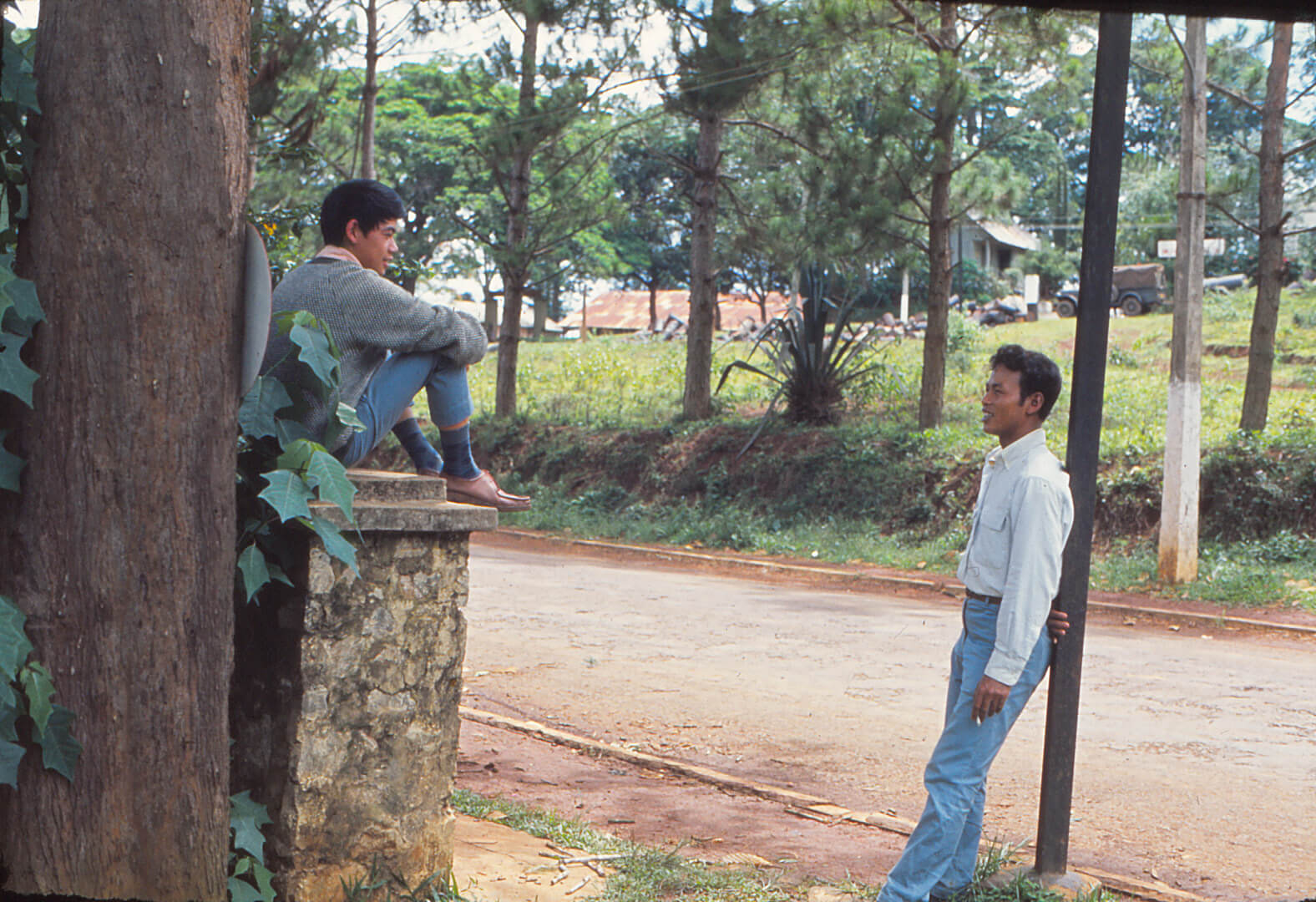
DiLinh 1967. Two young men who worked with us in our work with the tribal people - Ahn Viet and K'Krah.
Judy and I were sent to Di Linh, a small village in the highlands of Vietnam, to start a new project that served the growing displaced population of the Ko'ho people, one of the many tribal groups in the mountainous central part of Vietnam. We were joined by Betty Theissen, a Canadian Mennonite nurse, and Lee Brumback, a Lutheran agriculturist-interestingly also a conscientious objector, which is not common among Lutherans.
The only house for rent in town was a fairly large building that had earlier served as an annex of the small hotel on the main street. It was still owned and run by a Frenchman, François, a holdover from an earlier time of colonialism. A Polish man in the village had served in the French Foreign Legion during the French war. These two, plus a Canadian missionary couple, were the only expatriates in town until we arrived. The road through Di Linh was on the route from Saigon to the beautiful and cooler city of Da Lat, a summer capitol for the French colonialists, 50 miles to the north of us. During the war, the road south from Di Linh to Saigon was always controlled by the Viet Cong. Thus, it was not possible to travel in that direction. So, we were rather isolated in this picturesque village, though vulnerable to the whims of the Viet Cong and the North Vietnamese army at any time.

Saigon 1967 - Bret's baptism in Saigon in the Anglican church. When we returned in 1998, the church building had been turned into a karaoke bar!
Our son Bret was born in Nha Trang in the VNCS hospital where Judy and the baby were attended by Mennonite nurses and doctors. We'd moved to Saigon in June when I became Program Director of our agency with headquarters in the capitol.
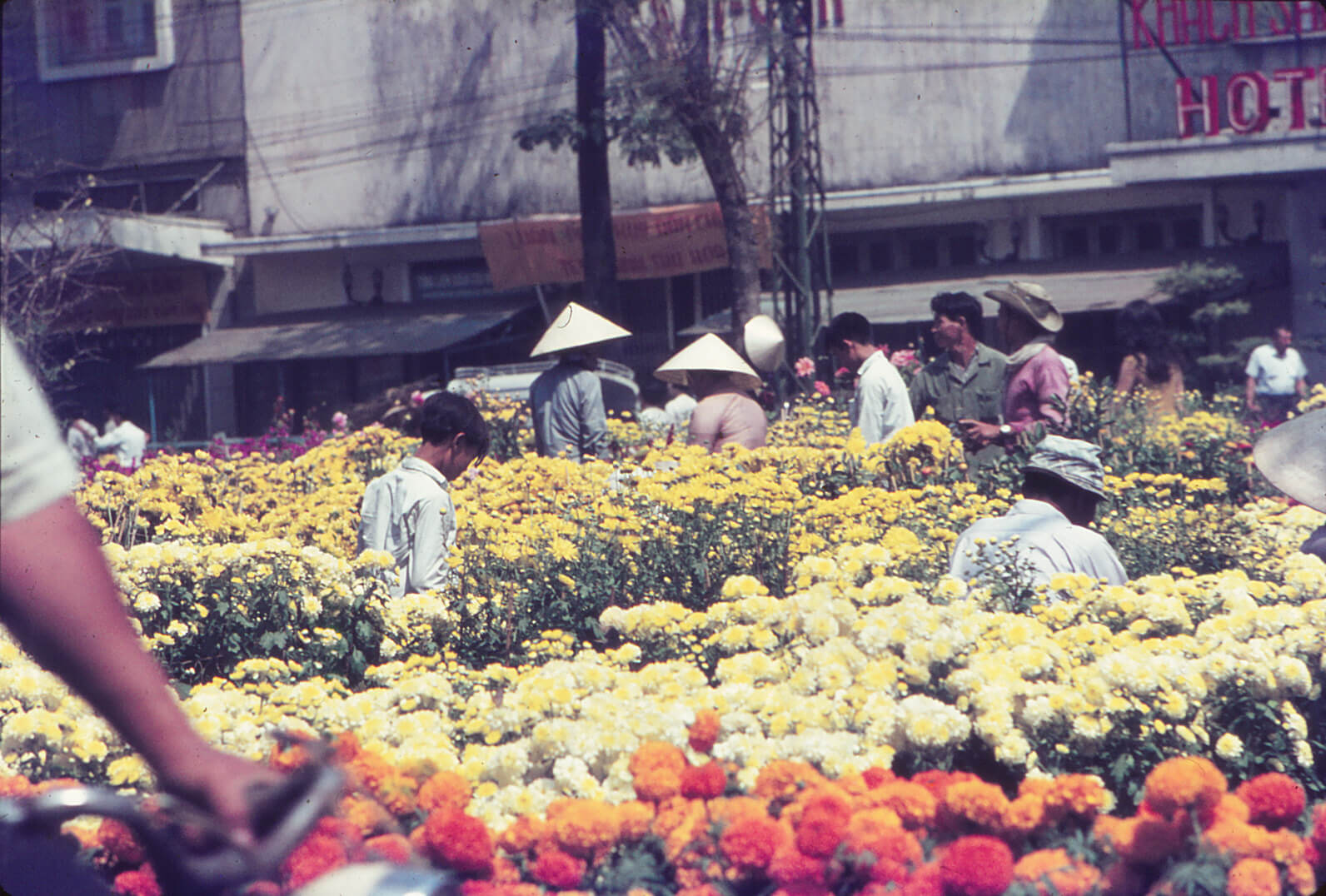
TET 1968. Flowers for sale filled Saigon streets getting ready for celebrating the Lunar New Year celebration.
Judy and I woke up to an eerie and unusual quietness on Cong Hoa street outside of the house where we lived in Cholon, the Chinese sector of Saigon. We had gone to bed before midnight to the sound of fireworks heard all over the neighborhood, the beginning of the lively festival of TET, the Chinese Lunar New Year's celebration. Earlier in the evening we took a drive through one of the busiest districts of the city to observe some of the carnival atmosphere.
Little did we know that the sound of fireworks had turned into the sound of gunfire while we slept.
We all expected that TET would mean that a cease fire would be observed, as soldiers from both sides would take this traditional break from war and spend a little time with their families. Little did we know that the sound of fireworks had turned into the sound of gunfire while we slept.
In that early morning hour, we did not know that we were already in the epicenter of the biggest offensive of the war, carried out by the North Vietnam Army (NVA), not only in Saigon but throughout the country - now generally felt to be a turning point in the war, the TET Offensive.
During those anxious days we were checking on all VNCS staff throughout the country to find out if they were safe! Indeed, we could report to anxious colleagues and families back home that we were all O.K. When Ove Nielsen in New York called my mother and said, "This is Ove Nielsen from LWR in New York" she burst into sobs before he could finish saying "we've just heard from Saigon that Judy, Jerry and Bret are safe". The reality was that folks back in the States were getting more information from newspapers and evening newscasts then we were right in the middle of it. The American public was alarmed, and rightly so.

Flowers in pedi-cyclos. It was said that this was one way the Viet Cong smuggled arms into Saigon.
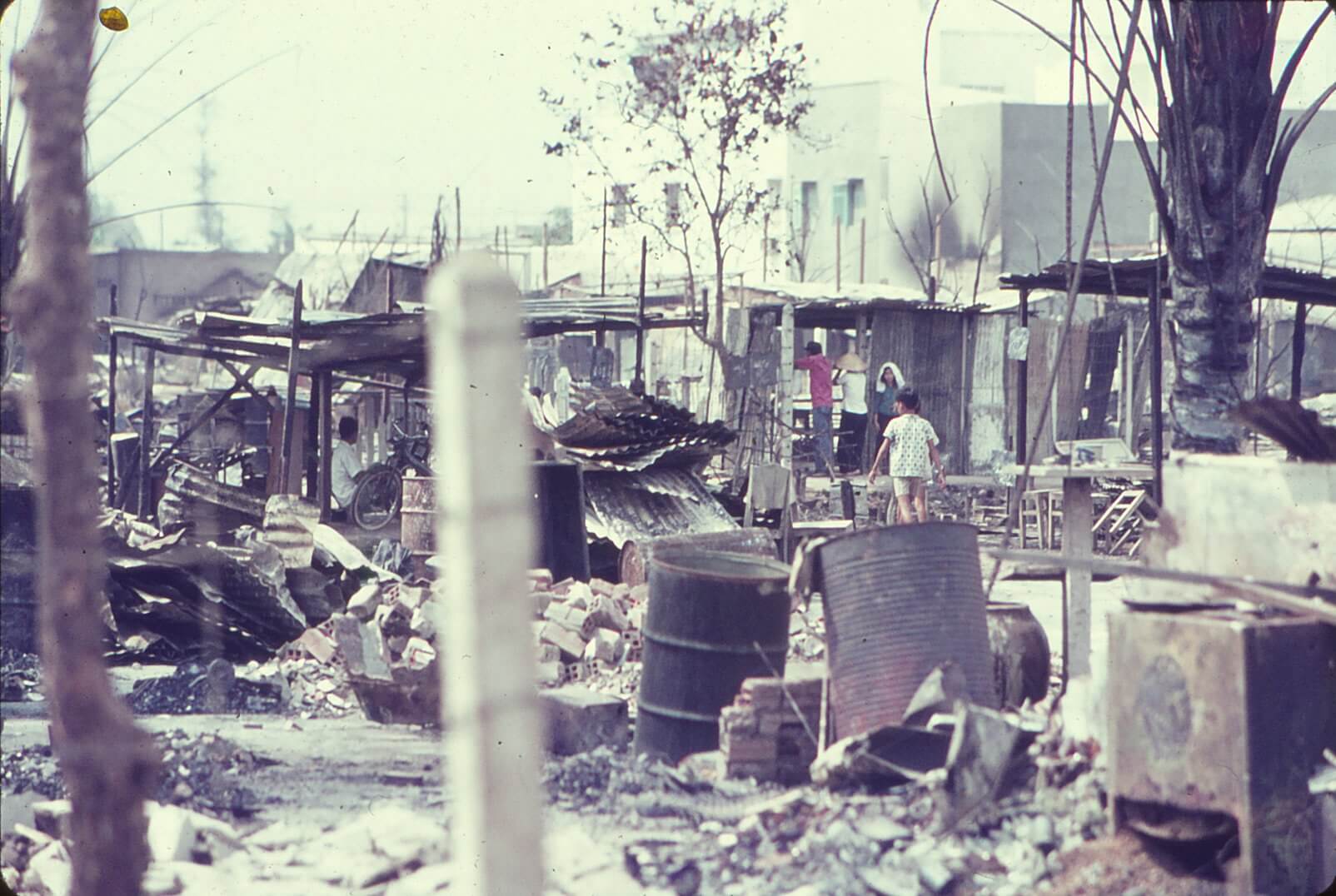
Picking up the pieces.
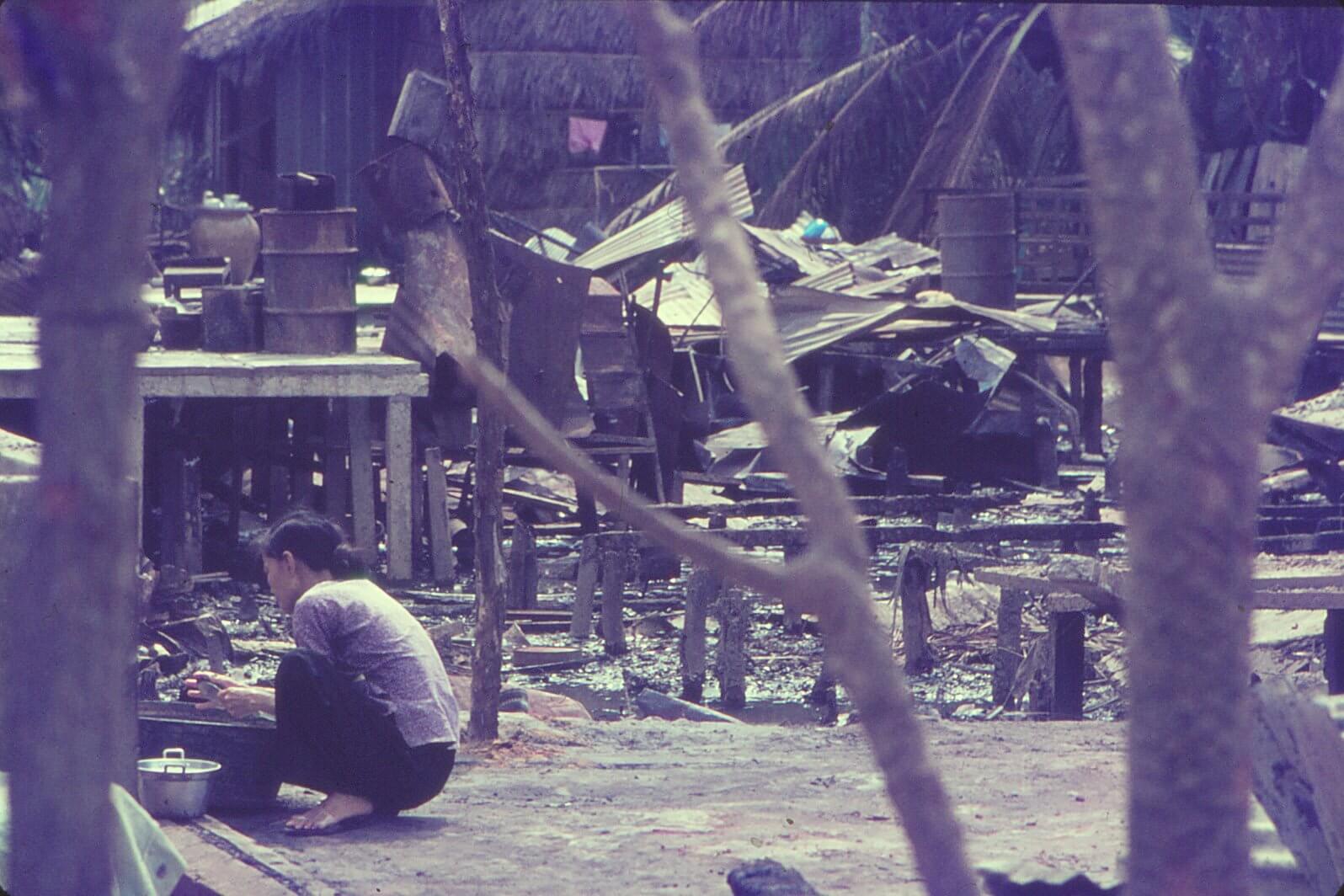
TET 1968. After the bombing of neighborhoods in Saigon, people try to get back to normal life.
The TET offensive is one of those times and places etched in my mind forever, the sounds, smells, sights, feelings; and the destruction we observed. Above all it was the solidarity and shared emotions we experienced with each other, both international colleagues and Vietnamese. And it reinforced our commitment to have a small part in ending that madness, or at least alleviating in some way the suffering it caused.
I wrote in my journal: "I feel the windows rattle and the house shake as the bombs fall; I saw a thousand homes that had been destroyed in a day; I listened to stories of people who lived through terror, who saw women and children killed and bombs fall from planes going overhead at hundreds of miles an hour; I saw fear in the faces of Vietnamese as night drew near and they wondered if they would see the morning; and I heard the proclamation of "military victory" and of 25,000 enemy killed in a week; (these are human beings - are we to be proud of this?) I saw refugees crowding in and the statistics raising. 112,000 in Saigon alone. And now we must pick up the pieces - there is much to be done, and we start slowly with some false starts and many frustrations; some of us bring kindling to the refugee areas, water to bombed out neighborhoods, bread to the needy. We realize how weak we are in the face of such massive need and destruction."
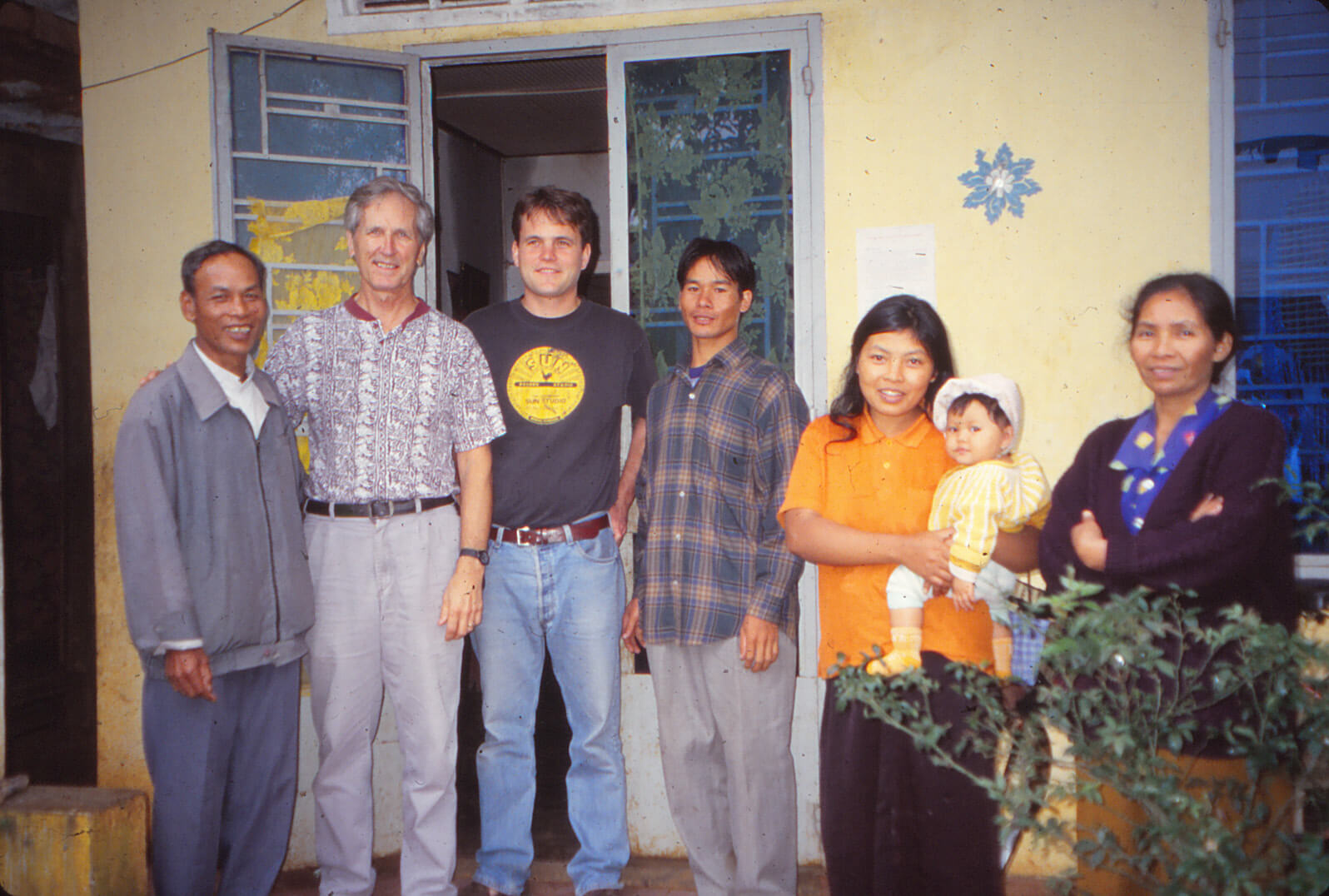
Visiting K'Krah's beautiful family. Bret, center, was born in Vietnam in '67.
Judy and I returned to Vietnam with our son Bret, now 31 years old. This was part of our commitment to bring Bret back to the place of his birth, and for us to see places of great emotional significance from our past. On this trip we traveled from Saigon, (now called Ho Chi Minh City) the approximately 150 miles north to Di Linh along the central highway, a route we had never taken during our years in Vietnam. As we approached Di Linh, we were astounded by the changes in the landscape. Land once sprinkled with a few tea plantations on the hillsides and rice paddies in the valleys was now completely taken over by coffee plantations.
Upon entering the town, we were initially disoriented. The outdoor market was not where it had been, the two Tin Lanh (Protestant) churches were gone, and the hospital where Judy worked was now a school of some sort. I walked past the little building that had served as a morgue at that time, and I remembered back to a tragic day in 1967 when the outskirts of our town had been attacked by a unit of the North Vietnamese Army (NVA). The next day I stood here looking on in dismay as a truckload of bodies, 30 or 40 Montagnard (tribal) soldiers was unloaded to a chorus of loudly sobbing wives, children and mothers.
We were like kids in a candy shop showing Bret the place we lived before he was born. We looked into some of the rooms, but did not go into the one that had been our bedroom.
We decided to go to the office of the Catholic Church to ask a few questions and get some orientation. There we were welcomed by two priests, one of whom we vaguely recognized. With reason because he was Fr. Quang, who has been serving as a priest in Di Linh since 1954! Fr. Quang said he remembered the work of our organization during the war. He said, "I have your secretary right here," and he went to the next room to call him. Out came K'krah, who as a young man had worked with us as assistant and interpreter, not a secretary. I recognized him immediately; thin and slightly hunched, his bronzed face was now etched with a few wrinkles. But it was his gentle smile that brought back memories of the mild demeanor that marked his character. This was one of those heart-stopping moments. What a delight and surprise for all of us!

DiLinh 1998. We reconnect with K'Krah after 30 years.
After a few minutes K'krah regained a bit of his English-a bit rusty for not speaking it for 25 years-and he started mentioning names of those with whom he had worked. "I remember Jerry Aaker," he said. Judy said, "This is Jerry Aaker," as K'rah's eyes widened and we all became a bit misty-eyed. He told us of people we had known and worked with, some now dead and others still living nearby. K'bret, our yard boy and the one from whom we had thought of the name for our son, is living with his parents in his village, he said, and we remembered the one-eyed teenager who always had a smile on his face.
K'krah is now working as a catechist with the Catholic Church, providing religious instruction to his own people, the Ko'ho. I didn't even know he was a Catholic; perhaps back then he wasn't. But we had precious little time to inquire or share anything about his faith journeys.
We walked down the street to our old house, and K'rah introduced us to the current occupants, who run a restaurant and hostel there now. We were like kids in a candy shop showing Bret the place we lived before he was born. We looked into some of the rooms, but did not go into the one that had been our bedroom. That was where Ted Studebaker, one of our successors, was killed in 1971.We've heard two versions of what happened on that awful night. What is quite certain is that this was one of those terrible "mistakes" that happen in war, not a planned attack by local Viet Cong or NVA soldiers. It is clear from many accounts that Ted was much loved by local Vietnamese and K'ho people. Ted was a conscientious objector from the Church of the Brethren, serving as a volunteer, and had recently married a young Chinese woman. K'krah said he was there on the night Ted was killed. "I carried his body out of the room," he said with an emotion that he clearly could not articulate to us well in English.
Then we went to K'Jong, which had been the refugee camp outside of town where we spent much of our time. It is now an extension of Di Linh, grown into a village with its own character. It was unrecognizable to us because of the lush tropical vegetation and permanent buildings which had grown up all around. K'krah proudly introduced us to his family, a beautiful wife, his daughter and her husband and baby. We carefully took down all the names of K'krah's eight children, took pictures and promised to try to communicate. But in his situation, we found out later, postal service either is nonexistent, or the letter that we sent later from Ho Chi Minh City was intercepted. We never heard back from him.
As we left Di Linh, many thoughts and questions circulated in my head. What about the many years of missionary work our neighbors George and Harriet Irwin, invested to build up the two Tin Lanh churches that are now torn down-one for Vietnamese and the other a vibrant tribal community? Was it worth the effort? They spent essentially their entire lives in Vietnam, and besides English spoke Vietnamese, Ko'ho, and French; and lived close to the people. What happens to the Church when it suffers? Living through years of war and violence, political turmoil, repression and fear, the organized church has endured much. The buildings were gone but, I trust, not all the followers. I asked K'krah, "What did you do when the government changed?" He said, "I was smart man. I went into the mountains with my family to live for several years." Eventually he came back and dedicated his life to Christ through work with the Catholic Church.
On this trip we traveled to many other parts of Vietnam; the most nostalgic journey was to Nha Trang to find the hospital where Bret was born in September, 1967. It was a fine little hospital staffed by Mennonite doctors and nurses, and it served thousands of Vietnamese patients for many years. It is no longer a hospital, but we were told it is now a rehabilitation center for ex-comrades. From what we could tell it looked more like an old people's home. But then, the "comrades" who fought in the war on the side of the North would be old now.
As we proceeded on our travels I thought about reconciliation. In the Cao Dai Temple where a large number of men and women in white, red and gold robes chanted for long periods sitting in the lotus position four times a day, I prayed in my own way. When we visited the Cu Chi tunnels in the part of the country that had been bombed more heavily than any piece of territory in the history of warfare, I prayed. I held a prayer of sorrow in my heart at the memorial with a large bust of Ho Chi Minh at its center and three tall walls with 44,000 names of Vietnamese who had died in combat in the French and American wars. That only counted those who died on the side of the victors-the Viet Cong and North Vietnamese-not the soldiers of the South Vietnamese army! What's more, those were the names of the fallen in only one province-Gia Dinh. We actually lived for a time on the far end of Gia Dinh which borders on what was then called Saigon. At night we frequently heard the bombing in the distance as the ground under our house reverberated.
The 50th anniversary of the TET Offensive brings back memories of our two years in Vietnam and especially living through those anxious days in February 1968. For some of us, TET was the beginning of the end of our time in Vietnam as Judy and Bret and other mothers and children were evacuated to Malaysia; and a few staff who could not continue with their projects were reassigned to other countries.

Di Linh -1998. Catholic priests with whom K'Krah now works as catechist. The Protestant churches had been taken down.
But most "VNCSers" persisted to do social work, distribute aid, bind wounds, care for the maimed, and show solidarity with the displaced and traumatized - until it came to an end when the NVA finally marched into Saigon in 1975.
Story Themes: 1968, Bret Aaker, Butte, Civilian, Civilians in Vietnam, Di Linh, Gerald Aaker, Jerry Aaker, Judy Aaker, Kenyon, Look, Montana, Read, Religion, Return to Vietnam, Return Trip, Tet Offensive, Vietnam Christian Service